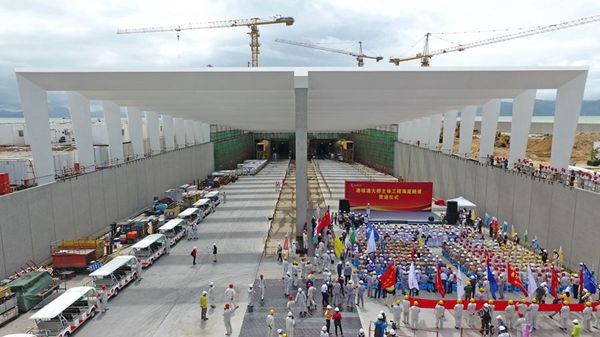 |
|
A ceremony was held on July 7 for the Hong Kong-Zhuhai-Macao Bridge undersea tunnel to mark the completion of the main structure of the world’s longest cross-sea bridge. The Hong Kong-Zhuhai-Macau Bridge is a super large sea-crossing passage, 55 km in length. The most difficult technique is the bridge-island-tunnel main project, which is about 29.6 kilometers long. [Photo/Xinhua]
|
The main structure of world’s longest sea bridge linking Hong Kong, Zhuhai and Macao was completed Friday, the builders said.
It took seven years to build the bridge, which will be open at the end of the year, said Zhu Yongling, director of the management bureau of the bridge.
The main structure measures 29.6 kilometers, consisting of a 22.9-km bridge section and 6.7-km underground tunnel. The bridge’s total length is 55 kilometers.
“The bridge passed all engineering risks, and we will prepare it for public use in a few months,” Zhu said.
Lin Ming, chief engineer of China Communications Construction Company, said they tackled great engineering challenges in building the bridge.
It used 420,000 tonnes of steel, enough to build 60 Eiffel Towers, and consumed 1.08 million cubic meters of cement.
Dubbed “the most technologically complicated bridge,” it crosses shipping lanes in the Lingding Ocean.
“We had to use immersed tubes. Due to lack of experience, it took us 96 hours to lay the first tube in the ocean, and many of the engineers and workers hardly slept for four consecutive days,” said Yin Haiqing, a leading engineer.
The bridge management bureau also issued a standard for the quality of cement.
“We needed several sections to go to work simultaneously, so we had 16 cement mixing stations in operation at the same time, and we ensured the cement they produced were of the same standard,” said another engineer Lu Huaying.
Designers also minimized the impact to the environment when building the bridge, which runs water that is home to Chinese white dolphins.
During construction, the number of the dolphins rose from 1,400 in 2009 to 2,100 in 2016, according to the management bureau.
The Y-shaped bridge will cut travel time between Hong Kong and Zhuhai from three hours to just 30 minutes, further integrating cities in the Pearl River Delta, said Wei Dongqing, deputy secretary of the management bureau’s Communist Party Committee.
read more


